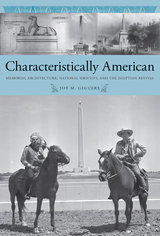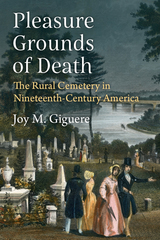2 books by Giguere, Joy

Characteristically American
Memorial Architecture, National Identity, and the Egyptian Revival
Joy M. Giguere
University of Tennessee Press, 2014
Prior to the nineteenth century, few Americans knew anything more of Egyptian culture
than what could be gained from studying the biblical Exodus. Napoleon’s invasion of
Egypt at the end of the eighteenth century, however, initiated a cultural breakthrough for
Americans as representations of Egyptian culture flooded western museums and publications,
sparking a growing interest in all things Egyptian that was coined Egyptomania.
As Egyptomania swept over the West, a relatively young America began assimilating
Egyptian culture into its own national identity, creating a hybrid national heritage that
would vastly affect the memorial landscape of the nineteenth and twentieth centuries.
Far more than a study of Egyptian revivalism, this book examines the Egyptian style
of commemoration from the rural cemetery to national obelisks to the Sphinx at Mount
Auburn Cemetery. Giguere argues that Americans adopted Egyptian forms of commemoration
as readily as other neoclassical styles such as Greek revivalism, noting that the
American landscape is littered with monuments that define the Egyptian style’s importance
to American national identity. Of particular interest is perhaps America’s greatest
commemorative obelisk: the Washington Monument. Standing at 555 feet high and
constructed entirely of stone—making it the tallest obelisk in the world—the Washington
Monument represents the pinnacle of Egyptian architecture’s influence on America’s desire
to memorialize its national heroes by employing monumental forms associated with
solidity and timelessness. Construction on the monument began in 1848, but controversy
over its design, which at one point included a Greek colonnade surrounding the obelisk,
and the American Civil War halted construction until 1877. Interestingly, Americans saw
the completion of the Washington Monument after the Civil War as a mending of the
nation itself, melding Egyptian commemoration with the reconstruction of America.
As the twentieth century saw the rise of additional commemorative obelisks, the Egyptian
Revival became ensconced in American national identity. Egyptian-style architecture
has been used as a form of commemoration in memorials for World War I and II, the civil
rights movement, and even as recently as the 9/11 remembrances. Giguere places the Egyptian
style in a historical context that demonstrates how Americans actively sought to forge
a national identity reminiscent of Egyptian culture that has endured to the present day.
than what could be gained from studying the biblical Exodus. Napoleon’s invasion of
Egypt at the end of the eighteenth century, however, initiated a cultural breakthrough for
Americans as representations of Egyptian culture flooded western museums and publications,
sparking a growing interest in all things Egyptian that was coined Egyptomania.
As Egyptomania swept over the West, a relatively young America began assimilating
Egyptian culture into its own national identity, creating a hybrid national heritage that
would vastly affect the memorial landscape of the nineteenth and twentieth centuries.
Far more than a study of Egyptian revivalism, this book examines the Egyptian style
of commemoration from the rural cemetery to national obelisks to the Sphinx at Mount
Auburn Cemetery. Giguere argues that Americans adopted Egyptian forms of commemoration
as readily as other neoclassical styles such as Greek revivalism, noting that the
American landscape is littered with monuments that define the Egyptian style’s importance
to American national identity. Of particular interest is perhaps America’s greatest
commemorative obelisk: the Washington Monument. Standing at 555 feet high and
constructed entirely of stone—making it the tallest obelisk in the world—the Washington
Monument represents the pinnacle of Egyptian architecture’s influence on America’s desire
to memorialize its national heroes by employing monumental forms associated with
solidity and timelessness. Construction on the monument began in 1848, but controversy
over its design, which at one point included a Greek colonnade surrounding the obelisk,
and the American Civil War halted construction until 1877. Interestingly, Americans saw
the completion of the Washington Monument after the Civil War as a mending of the
nation itself, melding Egyptian commemoration with the reconstruction of America.
As the twentieth century saw the rise of additional commemorative obelisks, the Egyptian
Revival became ensconced in American national identity. Egyptian-style architecture
has been used as a form of commemoration in memorials for World War I and II, the civil
rights movement, and even as recently as the 9/11 remembrances. Giguere places the Egyptian
style in a historical context that demonstrates how Americans actively sought to forge
a national identity reminiscent of Egyptian culture that has endured to the present day.
[more]

Pleasure Grounds of Death
The Rural Cemetery in Nineteenth-Century America
Joy M. Giguere
University of Michigan Press, 2024
Rural cemeteries—named for their expansive, picturesque landscape design rather than location—were established during the middle decades of the nineteenth century in the United States. An instant cultural phenomenon, Mount Auburn Cemetery in Cambridge, Massachusetts, was the nation’s first such burial ground to combine the functions of the public park and the cemetery, becoming a popular place to picnic and go for strolls even for people who didn’t have graves to visit. It sparked a nationwide movement in which communities sought to establish their own cities of the dead.
Pleasure Grounds of Death considers the history of the rural cemetery in the United States throughout the duration of the nineteenth century as not only a critical cultural institution embedded in the formation of community and national identities, but also as major sites of contest over matters of burial reform, taste and respectability, and public behavior; issues concerning race, class, and gender; conflicts over the burial of the Civil War dead and formation of postwar memory; and what constituted the most appropriate ways to structure the landscape of the dead in a modern and progressive society. As cultural landscapes that served the needs of the living as well as the dead, rural cemeteries offer a mirror for the transformations and conflicts taking place throughout the nineteenth century in American society.
Pleasure Grounds of Death considers the history of the rural cemetery in the United States throughout the duration of the nineteenth century as not only a critical cultural institution embedded in the formation of community and national identities, but also as major sites of contest over matters of burial reform, taste and respectability, and public behavior; issues concerning race, class, and gender; conflicts over the burial of the Civil War dead and formation of postwar memory; and what constituted the most appropriate ways to structure the landscape of the dead in a modern and progressive society. As cultural landscapes that served the needs of the living as well as the dead, rural cemeteries offer a mirror for the transformations and conflicts taking place throughout the nineteenth century in American society.
[more]
READERS
Browse our collection.
PUBLISHERS
See BiblioVault's publisher services.
STUDENT SERVICES
Files for college accessibility offices.
UChicago Accessibility Resources
home | accessibility | search | about | contact us
BiblioVault ® 2001 - 2024
The University of Chicago Press









